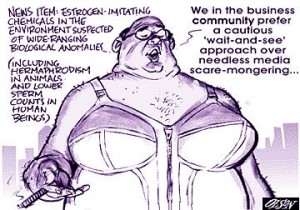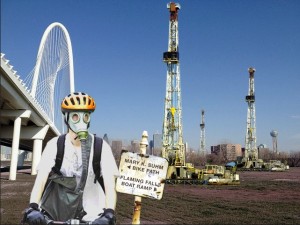Archive for July 2013
See North Texas Gas Problems Explode on Screen! GASLAND Part II Premieres on Monday
Most of you probably are already aware that Josh Fox's follow-up to "Gasland" will be premiering on HBO Monday night. What you might not know about "Gasland II" is that it heavily features North Texas. Former DISH Mayor Calvin Tillman, Earthworks organizer Sharon Wilson, and Parker County resident Steve Lipsky are all in there, and Lipsky's fight for his well water is a major story thread.
Like it or not, the Barnett Shale is where folks from the rest of the country and the rest of the world come to see what kind of damage fracking can leave in its wake.
Hard to believe it's been 3 years since Downwinders hosted the theatrical premiere of the original in October of 2010 with Fox showing up for a panel discussion that also featured former city councilwoman Angela Hunt afterwards at the Angelica. It was the first citywide show of opposition to gas drilling in Dallas and a full year before the packed Texas Theater showing where Mayor Mike Rawlings made his now famous pledge "to never put neighborhoods at Risk over money." But that was all so pre-secret deal ago.
This summer the City Plan Commission is meeting every two weeks to draft a new gas drilling ordinance for Dallas. By late August or early September, they're expected to be finished and have said they will then hold public hearings on the draft they'll submit to the City Council for a vote. Plans are under way to try and bring Josh Fox to Dallas for a theatrical premiere of his sequel as these public hearings kick-off. Nobody's sure if this can happen with Josh himself – he's become a genuine celeb since the first time around – but we're working on producing our own "sequel" to that very successful first showing. Stay tuned.
Meanwhile, you can send a quick e-mail to the Plan Commission members telling them what you'd like to see in a new gas drilling ordinance for Dallas by clicking here.
Another Study Links Autism to Air Pollution
 Women living in high air pollution areas while pregnant are up to twice as likely to have a child with autism as those living in low pollution areas, according to a study released June 18 by the National Institute of Environmental Health Sciences.
Women living in high air pollution areas while pregnant are up to twice as likely to have a child with autism as those living in low pollution areas, according to a study released June 18 by the National Institute of Environmental Health Sciences.
"What you see is the mothers with the 20 percent least exposure to pollutants, their children are least likely to have autism," lead researcher Dr. Andrea Roberts of the Harvard School of Public Health told The Standard-Times. "With each percentile of pollutant exposure, the presence of autism increased."
The study surveyed more than 300 women about the health of their children and compared the results to federal data on air pollution levels during the time and location of each mother's pregnancy. It's at least the second major study since March confirming a link between airborne pollution, but the evidence has been accumulating since 2006.
Autism is a disorder of brain development characterized by difficulty in social interaction, verbal and nonverbal communication and repetitive behaviors. Nationwide, 1 in 88 children have an autism spectrum disorder, according to the Center for Disease Control.
EPA Pushes Back Against Low-Dose Testing of Endocrine Disrupters
 Responding to a report last year that concluded the way EPA tests for harm from hormone-wrecking chemicals is out-of-date, the Agency itself published a review of its methodology last week that, not surprisingly, vindicated current practices.
Responding to a report last year that concluded the way EPA tests for harm from hormone-wrecking chemicals is out-of-date, the Agency itself published a review of its methodology last week that, not surprisingly, vindicated current practices.
In its annual "State of the Science" report, the EPA said that non-linear effects from exposure to endocrine disrupters have been documented, but concluded they were "rare" and did not constitute enough evidence to change the way the Agency assess toxic health harms.
“There currently is no reproducible evidence” that the low-dose effects seen in lab tests “are predictive of adverse outcomes that may be seen in humans or wildlife populations for estrogen, androgen or thyroid endpoints,” the agency report said. “Therefore, current testing strategies are unlikely to mischaracterize…a chemical that has the potential for adverse perturbations of the estrogen, androgen or thyroid pathways.”
Written by EPA officials with input from a team of scientists and managers from the Food and Drug Administration, the National Institute of Environmental Health Sciences and the National Institute of Child Health and Development, the draft was signed by Robert Kavlock, the EPA’s Deputy Assistant Administrator for Science.
Laura Vandenberg, the Tufts University researcher who headed up last year's study, "Hormones and Endocrine-Disrupting Chemicals: Low-Dose Effects and Nonmonotonic Dose Responses", responded by saying EPA's acknowledgement of endocrine disruption is a step forward, but added that the Agency had made some “odd, and possibly political decisions” in the new report.
"(The EPA's conclusions) fly in the face of our knowledge of how hormones work. They [endocrine disrupting chemicals] are overtly toxic at high doses but act like hormones, with completely different actions, at low doses.”
Vandenberg said the EPA used out-of-date studies on atrazine, when they should have used a new publication with dozens of authors from around the world showing the “consistent, low-dose effects of this chemical on amphibians, reptiles, fish, birds and mammals.”
Downwinders know that they are the recipients of low-level doses of hundreds, if not thousands of different chemicals trespassing into their lungs. They know that constant exposure to these chemicals, even at "safe levels" is harming them and their families. There are no computer models that can adequately reproduce what it's like to breath the air downwind of a waste-burning cement plant, a compressor station, or a trailer park masquerading as a lead smelter. Things happen on a molecular level that we are only now beginning to understand because we had no knowledge of the physiology of hormones or DNA when the toxicity tests EPA still uses were first imagined. Small stuff adds up.
But EPA is loath to admit this because it would mean turning the regulatory world upside down. If there are no "safe levels," there is no status quo. The system depends on the premise, however obsolete, that little bits of poison over a long period of time won't hurt most of us. It's this premise that Vendenberg and her colleagues were aiming at last year and it's this premise that EPA is defending in this newest report.
Take Another Hit – It Was the Best June for DFW Breathing Since 2007
 If this unseasonable cooler weather is making it seem like you're spending summer someplace other than DFW, it's also been the best "ozone season" in the region in seven years.
If this unseasonable cooler weather is making it seem like you're spending summer someplace other than DFW, it's also been the best "ozone season" in the region in seven years.
In the month that just ended, we only had four monitors on four days that violated the new 75 parts per billion smog standard that takes effect in 2018, and zero violations of the obsolete 1997 85 ppb standard. The maximum 8-hour reading was an 83 at the Denton Airport on June 3rd. Contrast that with last June: 54 violations of the 75 ppb standard and 27 violations of the 85 ppb standard over 9 days. Or 2011 – 24 violations of the 75 ppb standard, 7 violations of the 85 standard.
In fact, you have to go back all the way to 2007 when we had five violations of the 75 ppb standard but no "exceedences" of the 85 ppb, to find as good a June for air quality as we just had. And there are only a couple of other Junes – in 2010 and 2000 that even come close to being as full of safe and legal air. That's the good news.
The bad news is that these years were all followed by worsening air quality trends, that is, they turned out to be aberrations. So if this pattern holds, we'll have to wait until next summer to put it in context. As always, weather has a lot to do with how bad or good our ozone season is. The cooler and wetter, the better. The dryer and hotter, the worse. Just as this summer's cooler temps seem like they're out of place, by next June we could be thinking the same thing about our reprieve from smog.
The good news is that there's no questions that declining emissions in almost every category (we're looking at you oil and gas) have had a positive impact on the numbers. That's your doing. After 20 years of citizen effort, there's a lot less pollution from the cement plant complex in Midlothian, the coal plant belt in East Texas, and the millions of vehicles on and off the road.
For the EPA and the state, 2013 comes a year too late to help them recover from a terrible 2011 "clean air plan" that was supposed to get us down below 85 ppb by watching people purchase new cars. The clock officially ran out on that plan June 15th. Sales of new vehicles are dramatically up, so there's real displacement as old gas guzzlers get traded in for more efficient models. Whether those trade-ins are enough to cancel out the still-exploding growth rate of the area and rising gas and oil activity remains to be seen. That's why the EPA uses a three-year rolling average to determine transgressions against the Clean Air Act, to minimize the impact of anomalies.
You're just going to have to stay tuned to find out whether the summer of 2013 is the exception to the rule, or the re-writing of the rules.
Dallas Morning News Editorial On New Gas Ordinance
 Gets a lot of things right, but also leaves out a lot, like floodplains, air pollution, compressor stations, and full disclosure.
Gets a lot of things right, but also leaves out a lot, like floodplains, air pollution, compressor stations, and full disclosure.
The next City Plan Commission meeting on the drafting of the new ordinance is at 9 am,Thursday July 11th at Dallas City Hall in 5ES on the fifth floor. They're due to talk about operational conditions, i.e., hours, dust, noise, chemical disclosures, landscaping, monitoting an baseline testing.
Seems like a good time to mention that you can send the City Plan Commission a quick e-mail about what the new gas ordinance should contain by going to our "Featured Citizen Action of the Week."
